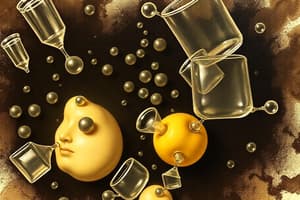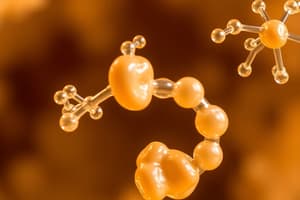Podcast
Questions and Answers
Was sind die Hauptfunktionen von Lipiden im Körper?
Was sind die Hauptfunktionen von Lipiden im Körper?
- Wasserlöslichkeit und Wärmeisolierung
- Säureproduktion und Enzymaktivierung
- Hormonsynthese und Neurotransmission
- Energiebereitstellung und Stützfunktion (correct)
Triglyceride sind eine Form von Lipoproteinen.
Triglyceride sind eine Form von Lipoproteinen.
False (B)
Nenne die drei Haupttypen von Lipiden.
Nenne die drei Haupttypen von Lipiden.
Triglycerid, Cholesterin, Phospholipid
Die _______ sind die Transportproteine für Lipide.
Die _______ sind die Transportproteine für Lipide.
Ordne die Lipoproteine den entsprechenden Eigenschaften zu:
Ordne die Lipoproteine den entsprechenden Eigenschaften zu:
Nach welchen Kriterien können Lipoproteine eingeteilt werden?
Nach welchen Kriterien können Lipoproteine eingeteilt werden?
Lipoproteine sind immer wasserlöslich.
Lipoproteine sind immer wasserlöslich.
Was wird bei der Dichtegradientenzentrifugation verwendet?
Was wird bei der Dichtegradientenzentrifugation verwendet?
Lipide sind in organischen ________ löslich.
Lipide sind in organischen ________ löslich.
Ordne die Lipidtransportmethoden den Beschreibungen zu:
Ordne die Lipidtransportmethoden den Beschreibungen zu:
Was sind die Hauptfunktionen der Chylomikronen?
Was sind die Hauptfunktionen der Chylomikronen?
VLDL wird in der Leber synthetisiert und ist ein Risikofaktor für Arteriosklerose.
VLDL wird in der Leber synthetisiert und ist ein Risikofaktor für Arteriosklerose.
Welche Fraktion wird mit HDL assoziiert?
Welche Fraktion wird mit HDL assoziiert?
LDL steht für ______.
LDL steht für ______.
Ordnen Sie die Lipoproteine ihren Hauptfunktionen zu:
Ordnen Sie die Lipoproteine ihren Hauptfunktionen zu:
Was sind typische klinisch-chemische Kenngrößen des Fettstoffwechsels?
Was sind typische klinisch-chemische Kenngrößen des Fettstoffwechsels?
Hyperlipoproteinämie ist ausschließlich eine primäre Störung des Lipoproteinstoffwechsels.
Hyperlipoproteinämie ist ausschließlich eine primäre Störung des Lipoproteinstoffwechsels.
Was ist das Hauptprotein der HDL-Lipoproteine?
Was ist das Hauptprotein der HDL-Lipoproteine?
Die Friedewaldformel wird zur Schätzung des ______ verwendet.
Die Friedewaldformel wird zur Schätzung des ______ verwendet.
Ordnen Sie die Lipoproteine den Referenzbereichen zu:
Ordnen Sie die Lipoproteine den Referenzbereichen zu:
Was ist die Wirkung von Lp(a) im Körper?
Was ist die Wirkung von Lp(a) im Körper?
Triglyceride sind das Hauptenergieprodukt des Kohlenhydratstoffwechsels.
Triglyceride sind das Hauptenergieprodukt des Kohlenhydratstoffwechsels.
Was bewirkt eine lange Venenstauung auf die Cholesterinwerte?
Was bewirkt eine lange Venenstauung auf die Cholesterinwerte?
Änderungen der Arterien, die auch als ______ bezeichnet werden, sind krankhafte Veränderungen.
Änderungen der Arterien, die auch als ______ bezeichnet werden, sind krankhafte Veränderungen.
Flashcards
Lipids
Lipids
Major nutrients and substances produced in the body; used for energy storage (as fat) and structural function (as organ components). Chemically diverse (mostly esters) and poorly water-soluble..
Triglycerides
Triglycerides
A type of lipid, crucial for energy storage.
Cholesterol
Cholesterol
Steroid lipid important for cell structure and hormone synthesis
Phospholipids
Phospholipids
Signup and view all the flashcards
Lipoproteins
Lipoproteins
Signup and view all the flashcards
Apolipoproteins
Apolipoproteins
Signup and view all the flashcards
Lipoprotein Electrophoresis
Lipoprotein Electrophoresis
Signup and view all the flashcards
Density Gradient Ultracentrifugation
Density Gradient Ultracentrifugation
Signup and view all the flashcards
Reference Method
Reference Method
Signup and view all the flashcards
Lipoprotein Classification
Lipoprotein Classification
Signup and view all the flashcards
Lipoproteins
Lipoproteins
Signup and view all the flashcards
Chylomicron
Chylomicron
Signup and view all the flashcards
VLDL (Very-low-density lipoprotein)
VLDL (Very-low-density lipoprotein)
Signup and view all the flashcards
LDL (Low-density lipoprotein)
LDL (Low-density lipoprotein)
Signup and view all the flashcards
HDL (High-density lipoprotein)
HDL (High-density lipoprotein)
Signup and view all the flashcards
Arteriosclerosis
Arteriosclerosis
Signup and view all the flashcards
Hyperlipoproteinemia
Hyperlipoproteinemia
Signup and view all the flashcards
Hypertriglyceridemia
Hypertriglyceridemia
Signup and view all the flashcards
Lipid profile/EP
Lipid profile/EP
Signup and view all the flashcards
Kühlschranktest
Kühlschranktest
Signup and view all the flashcards
Triglycerides
Triglycerides
Signup and view all the flashcards
Cholesterol
Cholesterol
Signup and view all the flashcards
LDL-Cholesterol
LDL-Cholesterol
Signup and view all the flashcards
Study Notes
Fettstoffwechsel
- Lipide sind Hauptnährstoffe und werden im Körper gebildet.
- Sie dienen der Energiebereitstellung (Depotfett) und Stützfunktion (Organfett).
- Lipide bestehen aus chemisch unterschiedlichen Stoffklassen (meist Ester).
- Lipide sind schlecht wasserlöslich, aber in organischen Lösungsmitteln löslich.
Einteilung der Lipide
- Triglyceride
- Cholesterin
- Phospholipide
Fettstoffwechsel - Transport der Lipide
- Transportproteine (Apolipoproteine) transportieren Lipide.
- Apolipoproteine + Lipide = Lipoproteine.
- Kern der Lipoproteine: Triglyceride und Cholesterinester.
- Hülle der Lipoproteine: Apolipoproteine, Phospholipide und Cholesterin.
Lipoproteine
- Lipoproteine unterscheiden sich in Größe und spezifischer Dichte.
- Zusammensetzung aus Lipid- und Proteinanteilen.
- Einteilung nach Mobilität in der Lipoprotein-/Lipidelektrophorese.
- Einteilung nach Dichte mittels Dichtegradientenultrazentrifugation.
Beispiele für Lipoproteine (mit % Anteile)
- Chylomikronen: Triglyceride (86-94%), Lipide (98-99%)
- VLDL: Triglyceride (55-65%) , Lipide (89-94%)
- LDL: Triglyceride ( 8-12%), Cholesterinester (35-40%) Lipide ( 75-80%),
- HDL: Cholesterinester (12-14%), Lipide (89-94%)
Lipoproteine - Bestimmung mittels Methoden
- Lipoproteinelektrophorese: Serumelektrophorese mit Lipidpräzipitation oder Färbung mit Fettfarbstoff.
- Dichtegradientenzentrifugation:ansteigender Gradient einer Salzlösung, Probe mehrer Stunden in mehreren Durchgängen ultrazentrifugiert
Störungen des Lipoproteinstoffwechsels
- Dyslipoproteinämie (Störung des Lipoproteinstoffwechsels)
- Hypolipoproteinämie (zu niedriger Lipoproteinspiegel)
- Hyperlipoproteinämie (primär/sekundär zu hoher Lipoproteinspiegel)
Einteilung der Hyperlipoproteinämien nach Fredrickson
- Unterscheidende Kategorien basieren auf Lipid-EP und sichtbaren Veränderungen im Serum.
Klinisch chemische Kenngrößen des Fettstoffwechsels
- Gesamtcholesterin
- HDL-Cholesterin
- LDL-Cholesterin
- Triglyceride + erweiterte Diagnostik: Lp(a), Apolipoproteine
Lipidnachweis und Einflussgrößen
- Nichteinhaltung der Ernährung/Alkohol-Kriterien, lange Venenstauung, Medikamente (z.B. Methyldopa) können die Werte fälschlicherweise beeinflussen.
Bestimmung von Gesamtcholesterin
- Enzym-Messung (CHOD, PAP)
Bestimmung von HDL-Cholesterin
- VLDL, LDL und Chylomikronen werden präzipitiert, HDL mittels CHOD-PAP Methode gemessen.
Bestimmung von LDL-Cholesterin
- Friedewald Formel oder CHOD-PAP, LDL-Trübungsmessung , UZ (LDL-Apherese).
Bestimmung von Triglyceride
- GPO-PAP Methode.
Störungen des Triglycerid- und Cholesterinstoffwechsels
- Hypertriglyceridämie (h. Triglyceride)
- Hypocholesterinämie (g. Cholesterin)
- Hypercholesterinämie (h.Cholesterin)
- primäre/sekundäre Formen
Apolipoproteine
-
Apolipoproteine sind Proteine, die an Lipide gebunden sind.
-
Apo A1 ist das Hauptprotein von HDL.
-
Apo B ist das Hauptprotein von LDL.
-
Immunologische Methoden (Turbidimetrie, Nephelometrie) werden zur Bestimmung von Apolipoproteinen verwendet.
Studying That Suits You
Use AI to generate personalized quizzes and flashcards to suit your learning preferences.



